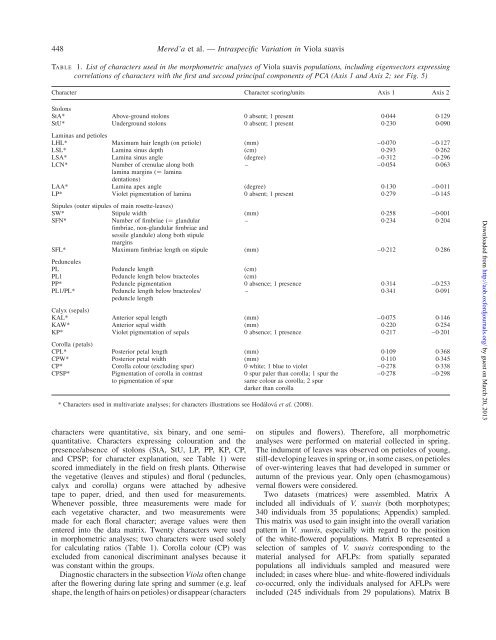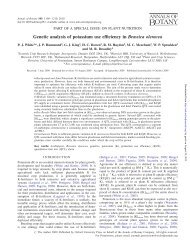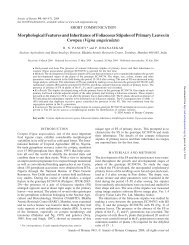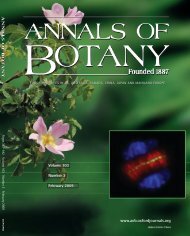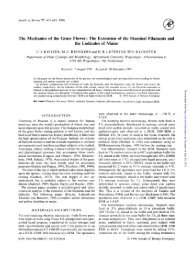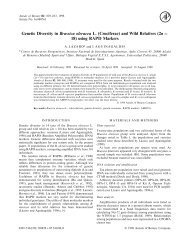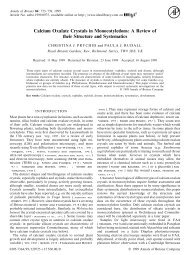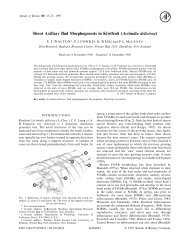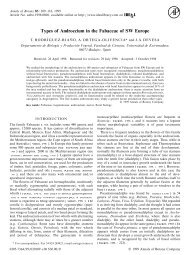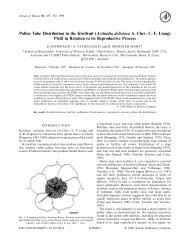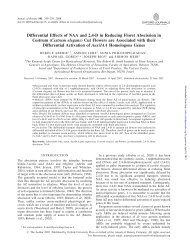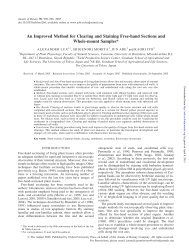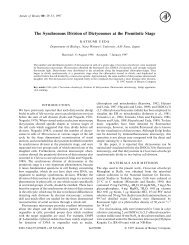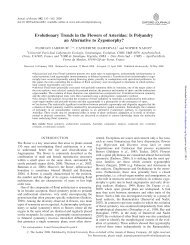Intraspecific Variation in Viola suavis in Europe ... - Annals of Botany
Intraspecific Variation in Viola suavis in Europe ... - Annals of Botany
Intraspecific Variation in Viola suavis in Europe ... - Annals of Botany
Create successful ePaper yourself
Turn your PDF publications into a flip-book with our unique Google optimized e-Paper software.
448<br />
TABLE 1. List <strong>of</strong> characters used <strong>in</strong> the morphometric analyses <strong>of</strong> <strong>Viola</strong> <strong>suavis</strong> populations, <strong>in</strong>clud<strong>in</strong>g eigenvectors express<strong>in</strong>g<br />
correlations <strong>of</strong> characters with the first and second pr<strong>in</strong>cipal components <strong>of</strong> PCA (Axis 1 and Axis 2; see Fig. 5)<br />
Character Character scor<strong>in</strong>g/units Axis 1 Axis 2<br />
Stolons<br />
StA* Above-ground stolons 0 absent; 1 present 0.044 0.129<br />
StU* Underground stolons 0 absent; 1 present 0.230 0.090<br />
Lam<strong>in</strong>as and petioles<br />
LHL*<br />
LSL*<br />
LSA*<br />
LCN*<br />
Maximum hair length (on petiole)<br />
Lam<strong>in</strong>a s<strong>in</strong>us depth<br />
Lam<strong>in</strong>a s<strong>in</strong>us angle<br />
Number <strong>of</strong> crenulae along both<br />
lam<strong>in</strong>a marg<strong>in</strong>s (¼ lam<strong>in</strong>a<br />
dentations)<br />
(mm)<br />
(cm)<br />
(degree)<br />
–<br />
–0.070<br />
0.293<br />
–0.312<br />
–0.054<br />
–0.127<br />
0.262<br />
–0.296<br />
0.063<br />
LAA*<br />
LP*<br />
Lam<strong>in</strong>a apex angle<br />
Violet pigmentation <strong>of</strong> lam<strong>in</strong>a<br />
(degree)<br />
0 absent; 1 present<br />
0.130<br />
0.279<br />
–0.011<br />
–0.145<br />
Stipules (outer stipules <strong>of</strong> ma<strong>in</strong> rosette-leaves)<br />
SW*<br />
SFN*<br />
Stipule width<br />
Number <strong>of</strong> fimbriae (¼ glandular<br />
fimbriae, non-glandular fimbriae and<br />
sessile glandule) along both stipule<br />
marg<strong>in</strong>s<br />
(mm)<br />
–<br />
0.258<br />
0.234<br />
–0.001<br />
0.204<br />
SFL* Maximum fimbriae length on stipule (mm) –0.212 0.286<br />
Peduncules<br />
PL Peduncle length (cm)<br />
PL1<br />
PP*<br />
PL1/PL*<br />
Peduncle length below bracteoles<br />
Peduncle pigmentation<br />
Peduncle length below bracteoles/<br />
peduncle length<br />
(cm)<br />
0 absence; 1 presence<br />
–<br />
0.314<br />
0.341<br />
–0.253<br />
0.091<br />
Calyx (sepals)<br />
KAL* Anterior sepal length (mm) –0.075 0.146<br />
KAW* Anterior sepal width (mm) 0.220 0.254<br />
KP* Violet pigmentation <strong>of</strong> sepals 0 absence; 1 presence 0.217 –0.201<br />
Corolla (petals)<br />
CPL*<br />
CPW*<br />
CP*<br />
CPSP*<br />
Posterior petal length<br />
Posterior petal width<br />
Corolla colour (exclud<strong>in</strong>g spur)<br />
Pigmentation <strong>of</strong> corolla <strong>in</strong> contrast<br />
(mm)<br />
(mm)<br />
0 white; 1 blue to violet<br />
0 spur paler than corolla; 1 spur the<br />
0.109<br />
0.110<br />
–0.278<br />
–0.278<br />
0.368<br />
0.345<br />
0.338<br />
–0.298<br />
to pigmentation <strong>of</strong> spur<br />
same colour as corolla; 2 spur<br />
darker than corolla<br />
* Characters used <strong>in</strong> multivariate analyses; for characters illustrations see Hodálová et al. (2008).<br />
characters were quantitative, six b<strong>in</strong>ary, and one semiquantitative.<br />
Characters express<strong>in</strong>g colouration and the<br />
presence/absence <strong>of</strong> stolons (StA, StU, LP, PP, KP, CP,<br />
and CPSP; for character explanation, see Table 1) were<br />
scored immediately <strong>in</strong> the field on fresh plants. Otherwise<br />
the vegetative (leaves and stipules) and floral (peduncles,<br />
calyx and corolla) organs were attached by adhesive<br />
tape to paper, dried, and then used for measurements.<br />
Whenever possible, three measurements were made for<br />
each vegetative character, and two measurements were<br />
made for each floral character; average values were then<br />
entered <strong>in</strong>to the data matrix. Twenty characters were used<br />
<strong>in</strong> morphometric analyses; two characters were used solely<br />
for calculat<strong>in</strong>g ratios (Table 1). Corolla colour (CP) was<br />
excluded from canonical discrim<strong>in</strong>ant analyses because it<br />
was constant with<strong>in</strong> the groups.<br />
Diagnostic characters <strong>in</strong> the subsection <strong>Viola</strong> <strong>of</strong>ten change<br />
after the flower<strong>in</strong>g dur<strong>in</strong>g late spr<strong>in</strong>g and summer (e.g. leaf<br />
shape, the length <strong>of</strong> hairs on petioles) or disappear (characters<br />
Mered’a et al. — <strong>Intraspecific</strong> <strong>Variation</strong> <strong>in</strong> <strong>Viola</strong> <strong>suavis</strong><br />
on stipules and flowers). Therefore, all morphometric<br />
analyses were performed on material collected <strong>in</strong> spr<strong>in</strong>g.<br />
The <strong>in</strong>dument <strong>of</strong> leaves was observed on petioles <strong>of</strong> young,<br />
still-develop<strong>in</strong>g leaves <strong>in</strong> spr<strong>in</strong>g or, <strong>in</strong> some cases, on petioles<br />
<strong>of</strong> over-w<strong>in</strong>ter<strong>in</strong>g leaves that had developed <strong>in</strong> summer or<br />
autumn <strong>of</strong> the previous year. Only open (chasmogamous)<br />
vernal flowers were considered.<br />
Two datasets (matrices) were assembled. Matrix A<br />
<strong>in</strong>cluded all <strong>in</strong>dividuals <strong>of</strong> V. <strong>suavis</strong> (both morphotypes;<br />
340 <strong>in</strong>dividuals from 35 populations; Appendix) sampled.<br />
This matrix was used to ga<strong>in</strong> <strong>in</strong>sight <strong>in</strong>to the overall variation<br />
pattern <strong>in</strong> V. <strong>suavis</strong>, especially with regard to the position<br />
<strong>of</strong> the white-flowered populations. Matrix B represented a<br />
selection <strong>of</strong> samples <strong>of</strong> V. <strong>suavis</strong> correspond<strong>in</strong>g to the<br />
material analysed for AFLPs: from spatially separated<br />
populations all <strong>in</strong>dividuals sampled and measured were<br />
<strong>in</strong>cluded; <strong>in</strong> cases where blue- and white-flowered <strong>in</strong>dividuals<br />
co-occurred, only the <strong>in</strong>dividuals analysed for AFLPs were<br />
<strong>in</strong>cluded (245 <strong>in</strong>dividuals from 29 populations). Matrix B<br />
Downloaded from<br />
http://aob.oxfordjournals.org/ by guest on March 20, 2013


